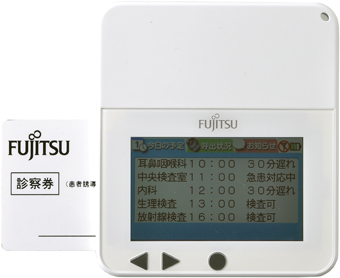
Clinics typically use electronic signage in waiting rooms to show visiting patients who will be called next, which requires all patients to stay near the waiting room. There is an increasing need, therefore, to find ways of relieving patients of the stress of waiting and enabling them to use their time more effectively. Furthermore, healthcare facilities are interested in finding ways to improve the services and amenities they provide to outpatients. To address this issue, Fujitsu began experimental testing at Fujitsu Laboratories and Fujitsu Clinic in 2009. The testing verified the feasibility of the solution that links electronic cardholders using electronic paper (e-paper) with an electronic medical record (EMR) system. The e-paper-based solution, now commercially available, connects electronic cardholders (made by Fujitsu General) utilising e-paper with both a patient navigation system, which guides patients to examination rooms or diagnostic testing rooms in medical facilities, and an EMR system. This enables detailed guidance information to be delivered to the electronic cardholder of an individual patient during their visit, from check-in and calling patients when the doctor is ready to see them to payment. Through the electronic cardholder, the solution shows outpatients their place in the queue when waiting for their consultation and will notify them when they are called through visual displays and vibration. As long as they are within signal range, outpatients do not need to stay in the waiting room, allowing them to spend their time waiting however they find most comfortable and least stressful. By reducing the time it takes for patients to make their way through, the medical facility can focus more on nursing care. As well, reducing the number of intake terminals and large information displays enables medical facilities to limit energy use and CO2 emissions. Paperless Connection The new e-paper-based outpatient guidance solution designed for use during the check-in process at medical facilities, such as hospitals and clinics, uses a proprietary wireless communications system from Fujitsu. Solution Features 1. Simplifies registration-By simply inserting an IC-equipped registration card, the electronic cardholder automatically links into the medical facility's electronic patient navigation system and EMR system, completing the registration process. 2. Conveys detailed information-The screen on the electronic cardholder can display the following items: (1) Today's Schedule, (2) Place in Line and (3) Updates. Message displays are accompanied by sound and vibration to keep the patient fully informed. Today's Schedule shows the scheduled time for the patient's consultation and related status information. Place in Line indicates how many patients are in the queue ahead. Updates display any messages of importance to the patient. 3. Helps clinics with environmental efforts-As the electronic cardholder uses color e-paper for its display, it consumes almost no power even when on and can run on a single charge for 1 week. In addition, as the registration functions of the electronic cardholder obviate the need for any registration process on subsequent visits, it saves the electricity that would otherwise be used in that process, helping to reduce power consumption and CO2 emissions. By tying in with Fujitsu's HOPE/EGMAINEMR system, the information that had previously been passed along through paper reservation slips is now displayed on the electronic cardholder, reducing paper consumption and further benefiting the environment. Practical Testing at Fujitsu Clinic From July to October 2009, Fujitsu tested 50 of the electronic cardholders at Fujitsu Clinic to assess them in terms of (1) low-power performance and operational cost savings in actual use, (2) wireless transmission performance and (3) quality of the information distribPrime Hype DF 2016 EP

 iConnectHub
iConnectHub
 Login/Register
Login/Register Supplier Login
Supplier Login


























